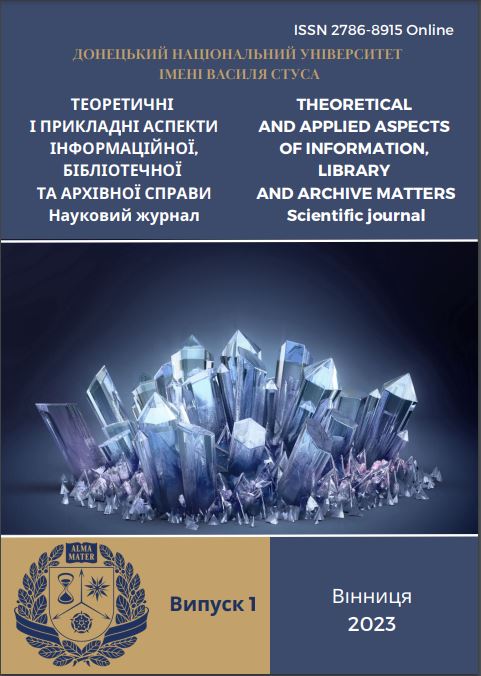General scientific and sociocommunication methodology of studying documentary and informational resources
Keywords:
document and information resource; document studies; general scientific methods; general historical methods; methods of socio-communication theoryAbstract
The article proposes and updates the applied aspects of the methodological scheme of document and information resource research. It is emphasized that the scientific-methodological understanding of the set of documents of a specific study is conceptual, with a generalized worldview, using the developments of the philosophy of history, which covers ontological issues of the historical process, as well as epistemological and logical-methodological problems of science. Documentary research of the problem is based on documentary sources that store information about the past and provide an opportunity to see events and processes, to understand information transmitted in space and time. The purpose of the work is the theoretical substantiation of the mechanisms of the introduction of general scientific, general historical, special socio-communication methods and the creation of a construct of a socio-communication information and analytical model for the study of document resources. Research methodology involves the use of methods of analysis and synthesis of scientific works from document studies, source studies, archival studies, social communications; the terminological method made it possible to reveal specific subject terms and definition of methodology concepts. The descriptive method made it possible to demonstrate the features of general scientific and socio-communication methods. The scientific novelty of the work consists in establishing the specificity of the methodological construct in working with documentary and informational resources of a specific documentary research. The practical implementation of the theoretical-methodological model of the study of document and information resources allows to identify the main components of the analysis for the purpose of establishing their socio-historical informativeness. This allows you to form a sequence of practical work with documentary and informational resources, which involves identifying documentary resources; monitoring and systematization; description / external criticism and attribution; internal criticism (informativeness); synthetic criticism; interpretation of the received data. The conclusions confirm the importance of intelligence and reveal the need for the formation of a complex of general scientific methods, general historical and special socio-communication methods in each specific scientific search. The proposed information-analytical model of application of methods of studying documentary information sources allows to build a sequence of application of methods of working with documentary and information resources.
References
Бездрабко В. В. Становлення і розвиток документознавства в Україні (друга половина XX – початок XXI ст.): автореф. дис. … д-ра іст. наук. 27.00.02. Київ, 2010. 36 с.
Британ В. Т. Історія України з давнини до початку XXI століття. Дніпропетровськ: НМетАУ, 2007. 170 с.
Дубровина Л. А. Классификация и научно-информационное описание коллекций и собраний в Национальной библиотеке Украины имени В. И. Вернадского. Библиотеки национальных академий наук: проблемы функционирования, тенденции развития. 2007. Вип. 5. С. 58–80.
Історичне джерелознавство. Київ: Либідь, 2002. 488 с. Ковальська Л. А. Кількісні методи дослідження Руху Опору в Україні (1941–1944 рр.). Гілея. Київ, 2011. № 46 (№ 4). С. 115–119.
Ковальська Л. А. Джерелознавчий дискурс історії радянського Руху Опору (1941–1945 рр.). Донецьк–Вінниця: ТОВ «Нілан-ЛТД», 2015. 462 с.
Ковальченко И. Д. Методы исторического исследования. Москва: Наука, 1987. 441 с.
Кулешов С. Г. Документ как исторический источник: свойство, состояние, статус. Архивоведение и источниковедение отечественной истории. Проблемы взаимодействия на современном этапе. Вып. I. Москва, 1997. С. 95–99.
Папакін Г. Джерела з історії ОУН та УПА радянського походження: схема класифікації, змістова сторона. Український історичний журнал. 2014. № 5. С. 174–190.
Подкорытов Г. А. Историзм как метод научного познания. Ленинград: ИЛУ, 1967. 190 с.
ронштейн А. П. Методика исторического источниковедения. Ростов н/Д.: Изд-во Рост. ун-та, 1976. 479 с.
Різун В. В. Начерки до методології досліджень соціальних комунікацій. Світ соціальних комунікацій. Т. 2. Київ: КиМУ, ДонНУ, 2011. С. 7–11.
Рюзен Й. Нові шляхи історичного мислення. Львів: Літопис, 2010. 358 с.
Смоленский Н. И. Теория и методология истории. Москва: Издательский центр «Академия», 2008. 272 с.
Холод О. М. Соціальні комунікації як поняття в науковій галузі «Соціальні комунікації». Інмутація суспільства в гіпермаркеті свідомості: у 3-х т. Т. 3. Київ: КиМУ, 2012. С. 213–222.
Холод О. М. Тенденції розвитку наукової галузі «Соціальні комунікації». Academia.edu. SanFrancisco, CA, USA. URL: www.academia.edu/15281389

